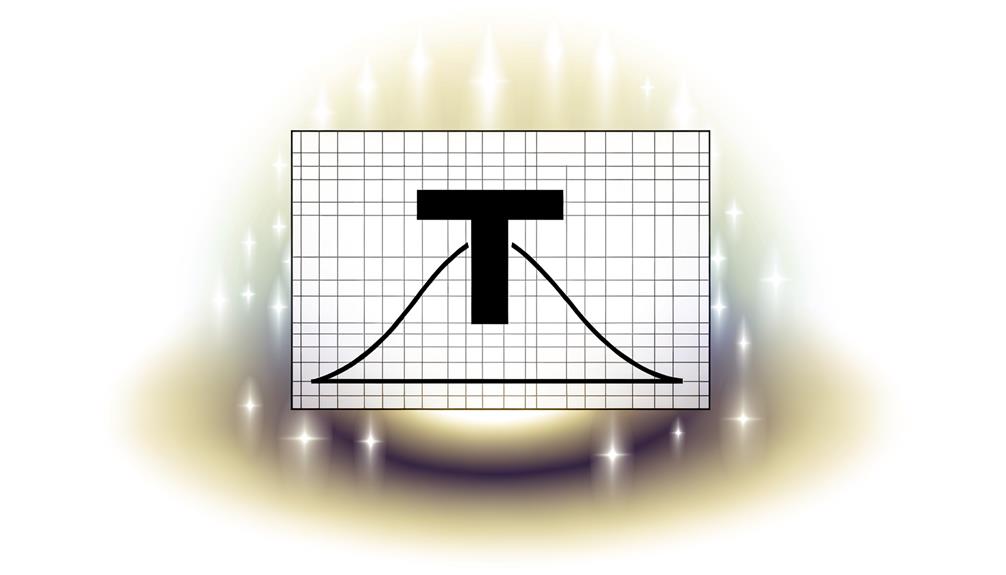Upside Down T Symbol Meaning in Mathematics
The upside-down T symbol, denoted as \(\perp\), holds essential significance across multiple fields. In mathematics, it represents orthogonality and perpendicularity, crucial for understanding vector spaces and computational stability.
Geometry uses it to indicate right angles and define shapes. In logic, it signifies contradiction or falsehood, important for formal proofs and arguments.
In coding, it denotes logical falsity or unsatisfiable conditions, enhancing program reliability. It also plays a role in statistics for hypothesis testing and parameter estimation.
This symbol is pivotal for engineers in designing and analyzing circuits. Understanding its diverse applications reveals deeper insights into each discipline.

Key Takeaways
- In mathematics, the upside-down T denotes orthogonality or perpendicularity.
- In logic, the symbol represents contradiction or falsehood.
- In programming, it signifies logical falsity or failure states.
- In statistics, it is related to the T distribution used in hypothesis testing.
- In electrical engineering, it denotes the ground or common return path.
Mathematical Significance

In the field of mathematics, the upside-down T symbol, also known as the perpendicular symbol (⊥), plays a significant role in denoting orthogonality and perpendicularity between lines, vectors, or planes.
This symbol is pivotal in linear algebra, where it signifies that two vectors are orthogonal if their dot product equals zero. In vector spaces, orthogonal vectors form the basis for orthonormal sets, which are critical for simplifying mathematical operations and ensuring computational stability.
In higher dimensions, the perpendicular symbol aids in expressing the normality of planes and hyperplanes. Its precise usage encapsulates fundamental concepts in mathematical theory and applications, making it an indispensable tool for professionals and researchers in engineering, physics, and computer science.
Role in Geometry
The perpendicular symbol (⊥) serves as a fundamental notation in geometry for indicating that two lines or segments intersect at a right angle, a concept essential for defining shapes, angles, and theorems in Euclidean space.
This notation is instrumental in establishing properties of geometric figures such as squares, rectangles, and right triangles. It aids in the derivation of key theorems like the Pythagorean theorem, where the perpendicular relationship between sides is essential.
Additionally, the symbol simplifies notation in proofs and constructions, enabling clearer communication of geometric principles. Understanding the use of ⊥ is crucial for comprehending more advanced geometric concepts, including orthogonality in vector spaces and the properties of perpendicular bisectors in triangle congruence.
Applications in Logic

Beyond its pivotal role in geometry, the upside-down T symbol (⊥) also finds significant applications in the field of formal logic, where it denotes the concept of contradiction or falsehood.
In logical systems, ⊥ is a fundamental element that represents an unsatisfiable proposition, serving as a cornerstone in proof theory and predicate logic. When a proposition leads to ⊥, it indicates that the proposition is inherently contradictory.
This symbol is essential in constructing proofs by contradiction, where demonstrating that an assumption leads to ⊥ is used to infer the truth of its negation.
In addition, ⊥ is employed in the sequent calculus and natural deduction, providing a means to formalize and analyze logical arguments rigorously.
Symbol in Coding
Within the field of programming, the upside-down T symbol (⊥) plays a pivotal role in certain coding paradigms, particularly in denoting logical falsity or failure states in formal verification and functional programming languages.
In formal verification, ⊥ often indicates an unsatisfiable condition or an error state, ensuring that programs adhere to specified correctness properties. Functional programming languages like Haskell utilize ⊥ to represent undefined values or computations that fail to produce a result, also known as bottom values. This symbol helps developers handle exceptional cases robustly, aiding in the creation of more reliable and maintainable code.
Additionally, ⊥ can be instrumental in type theory to denote types with no inhabitants, thereby enhancing type safety and program correctness.
Use in Statistics

In the field of statistics, the upside-down T symbol, often referred to as the T distribution, plays a vital role in hypothesis testing, enabling statisticians to assess the validity of their assumptions.
It is integral to T distribution analysis, which is used to estimate population parameters when sample sizes are small.
Additionally, the T distribution is fundamental for constructing confidence intervals, providing a range within which the true population parameter is likely to fall.
Statistical Hypothesis Testing
The upside-down T symbol, often represented as '⫥', holds significant importance in statistical hypothesis testing, particularly in denoting independence between variables.
In hypothesis testing, this symbol is used to express the null hypothesis that two events or variables are independent. Independence is an essential assumption in many statistical tests, such as chi-square tests and tests for correlation.
By formally stating that variables are independent using '⫥', researchers can rigorously test if observed data deviates significantly from this assumption. This symbol ensures clarity and precision in statistical communication, aiding in the formulation of hypotheses and interpretation of test results.
Therefore, '⫥' serves as a foundational element in the robust analysis of statistical relationships.
T Distribution Analysis
Building on the concept of statistical independence, the T distribution plays a pivotal role in scenarios where sample sizes are small and population standard deviations are unknown, offering a robust method for estimating population parameters and conducting hypothesis tests.
This distribution, characterized by heavier tails than the normal distribution, accounts for the additional variability introduced by smaller samples. The degrees of freedom, derived from sample size minus one, critically influence its shape.
As sample size increases, the T distribution converges to the standard normal distribution. Its application is indispensable in Student's t-tests, which compare sample means to a known value or between groups, ensuring reliable and accurate inferential statistics even under less-than-ideal conditions.
Confidence Interval Calculation
How does one quantify the precision of an estimated population parameter derived from sample data? The answer lies in the concept of a confidence interval.
A confidence interval provides a range of values within which the true population parameter is expected to lie, with a certain level of confidence.
To calculate a confidence interval, follow these steps:
- Determine the sample mean (�̄) and standard deviation (�): These are fundamental statistics derived from your sample data.
- Select a confidence level (e.g., 95%): This indicates the degree of certainty that the interval contains the population parameter.
- Calculate the margin of error: Use the formula \( ext{Margin of Error} = z^* imes rac{s}{\sqrt{n}} \), where \( z^* \) is the critical value from the Z-distribution.
Engineering Contexts
In engineering contexts, the upside-down T symbol serves as an important indicator for structural load distribution and is also essential in circuit design schematics.
Specifically, this symbol can denote load-bearing points in architectural blueprints or represent ground connections in electrical diagrams.
Understanding its application guarantees precise communication and accuracy in complex engineering projects.
Structural Load Indicators
Within the field of structural engineering, the upside-down T symbol is frequently utilized as a critical indicator of load-bearing capacities, guaranteeing that stress distribution is accurately assessed and managed. This symbol serves as a visual cue for engineers to evaluate the structural integrity of various components.
Proper understanding and application of this symbol can significantly enhance the safety and durability of engineering projects. Key considerations include:
- Load Capacity Identification: Denotes the maximum weight a structure can safely bear.
- Stress Distribution Analysis: Helps in determining how forces are spread across structural elements.
- Safety Compliance: Guarantees adherence to engineering standards and regulations.
Circuit Design Symbols
Understanding the various circuit design symbols is crucial for engineers to effectively convey complex electrical schematics and guarantee accurate communication across multidisciplinary teams. These symbols include representations for resistors, capacitors, inductors, diodes, and transistors, each playing a critical role in the functionality of electronic circuits.
Mastery of these symbols guarantees that engineers can design, analyze, and troubleshoot circuits with precision. The 'upside down T' symbol, specifically, denotes ground or a common return path for electric current, a foundational element in circuit stability.
Familiarity with such symbols is paramount in fostering a shared technical language, enabling seamless collaboration, and ensuring that designs meet intended specifications and safety standards. This expertise underpins the reliability and efficiency of modern electrical systems.
Philosophical Interpretations

The upside-down T symbol, often referred to as the 'perpendicular' symbol, has been interpreted by various philosophers as a representation of the intersection between the material and the metaphysical domains.
This symbol has been seen as embodying the convergence of:
- Physical Reality: The horizontal line represents the tangible, observable universe.
- Transcendental Thought: The vertical line symbolizes spiritual or abstract dimensions.
- Human Experience: The intersection point illustrates where human consciousness bridges the gap between the physical and metaphysical spheres.
Such interpretations provide a profound framework for understanding how individuals perceive their existence and their connection to broader cosmological constructs.
Philosophers argue that this duality encapsulated in the upside-down T symbol offers a unique lens through which to explore the complexities of human nature and reality.
Conclusion
The upside down T symbol, also known as the perpendicular symbol, holds multifaceted significance across various domains.
In mathematics, it denotes orthogonality; in geometry, it signifies perpendicular lines.
Logic employs it to represent conjunction, whereas coding integrates it for specific algorithmic functions.
Statistical analyses use it in hypothesis testing, and engineering contexts apply it in design schematics.
Philosophical interpretations further enrich its conceptual depth, illustrating the symbol's versatility and profound utility across disciplines.




